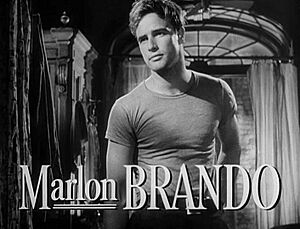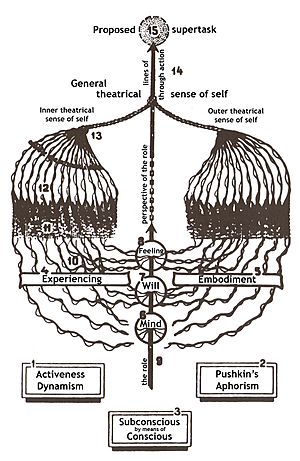Method acting facts for kids

Method acting, often called the Method, is a way actors prepare for roles. It helps them give honest and strong performances. Actors try to deeply understand and feel what their character is thinking and feeling. These techniques are based on the "system" created by Konstantin Stanislavski. He was a famous Russian actor and director. His ideas are found in his books like An Actor Prepares.
Three important teachers in New York helped develop these ideas further. They were Lee Strasberg, Stella Adler, and Sanford Meisner. Strasberg focused on the character's inner thoughts. Adler looked at how society affects a character. Meisner taught actors to focus on how characters behave.
Contents
How Method Acting Developed
"The Method" grew from the acting "system" created by Konstantin Stanislavski (1863–1938). In the early 1900s, Stanislavski organized his training methods. He wanted actors to prepare for roles in a very detailed way. His "system" combined ideas from different theatre groups. It brought together a unified vision for plays and a team approach to acting. It also used realistic acting styles from other famous theatres.

Stanislavski's "system" teaches actors to truly "experience" a role. This is different from just "showing" or "imitating" a character. It uses an actor's conscious thoughts and will to unlock deeper feelings. These feelings include emotions and subconscious actions. During rehearsals, actors look for reasons why their character acts a certain way. They also define what the character wants to achieve in each moment. This is called a "task."
Later, Stanislavski added more physical exercises to his "system." This was called the "Method of Physical Action." Instead of just talking about the play, actors would improvise scenes. Stanislavski believed that "the best analysis of a play is to take action in the given circumstances."
Another person who influenced the Method was Yevgeny Vakhtongav. He was a Russian-Armenian student of Stanislavski. Vakhtangov's "object exercises" helped actors train and keep their skills sharp. These exercises helped actors understand the difference between a character's motivations and an actor's personal experiences.
Method Acting in the United States
Stanislavski's early ideas came to the United States in the 1920s. Students from his Moscow Art Theatre (MAT) shared his "system." This changed acting in the West. Richard Boleslawski and Maria Ouspenskaya, two of Stanislavski's students, moved to the US. They started the American Laboratory Theatre.
However, the version of Stanislavski's work they brought was from the 1910s. It wasn't the full, later version of his "system." His complete ideas were in books like An Actor's Work from the 1930s. The first part of An Actor's Work was published in the US as An Actor Prepares in 1936. Many English readers thought this one book was the entire "system." Many American actors who became known for the Method learned from Boleslawski and Ouspenskaya. Their students, like Lee Strasberg, Stella Adler, and Sanford Meisner, then developed their own approaches. These are often confused with Stanislavski's original "system."
Stella Adler was an actress and acting teacher. Famous students like Marlon Brando, Warren Beatty, and Robert De Niro studied with her. Adler's version of the Method taught actors to imagine the scene's situation. They would use their imagination to create emotions, rather than recalling their own past experiences. She encouraged actors to use "as ifs." This means imagining situations that feel personal to the actor, even if they are not exactly what the character experiences.
Some famous directors and actors had different views on Method acting. Alfred Hitchcock found working with Montgomery Clift difficult. He said Clift was a "method actor." Lillian Gish joked, "It's ridiculous. How would you portray death if you had to experience it first?" Charles Laughton felt that Method actors gave a "photograph" of a character. He thought "real actors" gave an "oil painting."
During the movie Marathon Man (1976), Laurence Olivier famously joked with Dustin Hoffman. Hoffman had stayed up all night to feel like his character. Olivier suggested Hoffman "try acting... It's so much easier." Hoffman later explained that Olivier was just joking. He knew Hoffman had been out all night for personal reasons.
Strasberg taught many well-known American actors. These included Paul Newman, Al Pacino, Dustin Hoffman, James Dean, Marilyn Monroe, and Jack Nicholson.
Method Acting in India
In Indian cinema, a form of Method acting developed on its own. Dilip Kumar, a Hindi cinema actor, started in the 1940s. He became a huge Indian movie star in the 1950s and 1960s. He was a pioneer of this technique, even before Hollywood Method actors like Marlon Brando. Kumar inspired many Indian actors, including Amitabh Bachchan and Naseeruddin Shah. Filmmaker Satyajit Ray called Kumar "the ultimate method actor."
In South India, actors like Sathyan and Sivaji Ganeshan practiced Method acting. Later, prominent actors such as Mammootty, Mohanlal, and Kamal Haasan also used these techniques.
Method acting is gaining more attention in India today. This is partly due to the rise of OTT streaming platforms. These platforms feature many popular web series. They explore new types of stories not often seen in Indian cinema. This has given a platform to a new generation of Method actors. These include Rajkumar Rao, Amit Sadh, and Vicky Kaushal.
Acting Techniques
Method acting uses several concepts and techniques. These include substitution, "as if," sense memory, and affective memory. Stanislavski first developed all these ideas. Sometimes, modern Method actors even get help from psychologists to develop their roles.
In Strasberg's approach, actors use experiences from their own lives. This helps them connect with their characters' feelings. This technique is called emotion memory (or "affective memory"). It involves remembering sensations from past experiences that had a strong emotional impact. Actors let these sensations create a response naturally, without forcing it.
Stanislavski was also very interested in Perezhivanie. This means "re-living" emotional experiences. He believed actors needed to go beyond just imitating. He encouraged them to deeply explore their emotions. He thought actors needed to truly experience what their character was feeling.
Later, Stanislavski changed his approach. He mostly moved away from emotion memory. He focused more on physical actions as a way to express emotions indirectly. He believed that what a character does physically could lead to the right feelings.
However, in training, recalling sensations to create emotional experiences remained important. Imagining vivid fictional experiences was also a key part of Stanislavski's work. It also stayed central to the different Method-based approaches that followed.
A common misunderstanding about Method acting is that actors stay in character all the time. This means even when they are not on stage or filming. Stanislavski did experiment with this idea early in his career. But he found it didn't work well and soon stopped using it. While some Method actors, like Daniel Day-Lewis, choose to do this, it is not a required part of the Method. Lee Strasberg did not teach it as part of his Method approach.
While Strasberg focused on memory recall, Stella Adler's approach was different. She believed actors should find the truth in the script itself. They should explore the character's inner emotions, experiences, and situations. Her teachings are carried on by Larry Moss, one of her students. Moss wrote an acting textbook called The Intent to Live. In it, he explains Adler's basic techniques. He talks about "given circumstances." These are the facts about the character provided in the script. He also discusses "interpretation." These are the truths about the character that are not in the script. This is where the actor makes assumptions about their role.
According to Moss, actors need to know three things about their character. These are objectives, obstacles, and intentions. The "objective" is what a character wants to achieve in a scene. The "super objective" is the character's main wish or dream throughout the whole story. An "obstacle" is what stops the character from reaching their objectives. "Intention" refers to the actions a character takes to overcome obstacles and achieve their goals. Moss believes that understanding these things helps actors find truth in their performance. This creates a realistic portrayal. He emphasizes that the actor doesn't become the character. Instead, the character lives through the actor's understanding of the character's truths within themselves.
How Acting Affects Actors
Method acting can be very demanding for actors. It often involves exploring deep emotions. Actors might revisit past feelings, both happy and challenging. This can be emotionally tiring if not managed carefully. However, actors often develop strong skills in managing their emotions. This might be because they constantly need to create and control different feelings.
When actors only change their actions without changing their deeper thoughts, it can lead to fatigue. This is called "surface acting." Method acting, when done well, is more like "deep acting." This means changing both thoughts and actions. Deep acting generally helps avoid too much emotional tiredness. Surface acting can sometimes lead to negative moods, anxiety, or feelings of shame. It can also affect sleep.
However, acting, including Method acting, can also be very beneficial. Research shows that actors are often very good at understanding other people's thoughts and feelings. This is called "theory of mind." Acting can also improve a person's empathy. This is the ability to understand and share the feelings of others. It has been suggested that young people trained in the Method can better understand their own emotions and those of others. Actors have also been found to have improved memory skills. Studies have shown that when non-actors learn actors' memorization techniques, their memory improves significantly.
See also
- Ivana Chubbuck
- Ion Cojar
- List of acting techniques
- Konstantin Stanislavski

